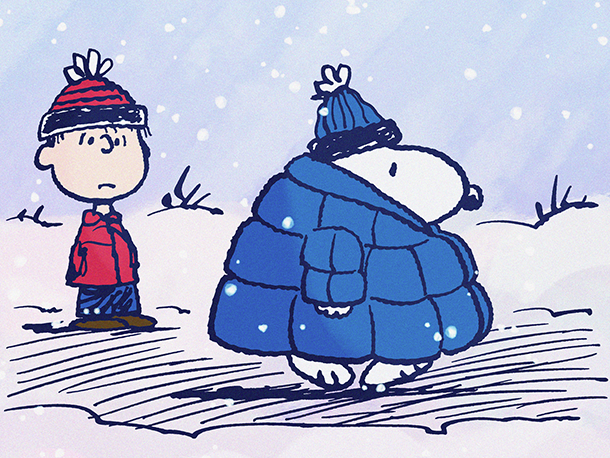Section Branding
Header Content
Gen Z is suddenly obsessed with Snoopy — and not just because he's cute
Primary Content
Updated December 18, 2023 at 8:20 AM ET
It's Snoopy's world, and Gen Z is just living in it – apparently.
The anthropomorphic, imaginative beagle made his Peanuts comic strip debut in October 1950. More than half a century later he's winning over yet another generation of fans, with the TikTok views and sold-out store shelves to prove it.
Take, for example, Puffer Jacket Snoopy: a plushie wearing a striped hat and blue coat, just like the one that hand-drawn Snoopy started rocking in 1984.
The toy has become so elusive that teens and twenty-somethings are going viral for filming themselves scouring CVS stores simply trying to track one down. It retailed (when it was in stock) for around $15, but is being resold on sites like eBay for as much as $100.
Sure, it's a comforting likeness of a beloved character in a trendy outfit, for what at least used to be a reasonable price. But there's much more going on, says Elise Hannum, an assistant editor at The Atlantic who recently authored a Snoopy essay titled "The Hero Gen Z Needs."
"There is a certain amount of 'I was there, I got this thing at the peak of the Snoopy craze,' too, that might be appealing to people," she told NPR's Morning Edition.
For months, social media platforms like TikTok and Instagram have been flooded with memes, clips and stills of Snoopy in action, clipped from decades-old comic strips and animated TV specials.
Snoopy merch everywhere is selling out, from the online exclusive Build-a-Bear to many of the items in Peanuts' collaborations with apparel brands like Aeropostale.
"I think there is a staying power to Snoopy specifically that people are continuing to identify with," Hannum said.
But why Snoopy, and why now?
Here's what to know about the craze — and what Peanuts and pop culture experts think might be behind it.
Snoopy is driving engagement, sales and even blood donations
It's not as if Snoopy — the face of beloved TV specials and a fixture of the Macy's Thanksgiving Day Parade — ever really went away (other than to space, of course). But old-school Snoopy has reached whole new heights of fame in recent months.
Melissa Menta, senior vice president of marketing and communications for Peanuts Worldwide, says every generation has effectively "discovered Snoopy" as it grows up. But zoomers' embrace of the character is playing out a little differently, thanks to platforms like TikTok.
"Social media allows it to become more viral and more present to us," she told NPR.
Menta said the official Snoopy TikTok account saw a 223.8% increase in engagements between the second and third quarter of this year. During that time it gained 198,000 new followers, which she called "the highest growth the account has ever seen."
Similarly, Gina Huntsinger, director of the Charles M. Schulz Museum and Research Center in Santa Rosa, Calif., told NPR that its Instagram reach has been up over 200% in the last 30 days, with engagement highest among 18- to 24-year-olds.
All the online love has translated into a real-life spike (pun intended) in sales.
The museum has seen its highest attendance in its 21-year history this past quarter, Huntsinger said, and its gift shop's top seller is currently a small Snoopy plush.
"Snoopy's, of course, been the favorite, I would have to say, of characters in the Peanuts comic strip," Huntsinger added. "[Charlie Brown is] the guy who has those losses that we all can relate to ... But Snoopy is the one who's got a better imagination. He's what we want to be."
Snoopy is so hot, in fact, that youths have literally given blood just to get a T-shirt featuring one of his alter egos: the perpetually laid-back, sunglasses-clad college kid Joe Cool (see also: rizz).
The Red Cross held a Peanuts-themed promotion in April, rewarding donors with "be cool give blood" tees that caused a minor frenzy of their own. The organization gave out nearly 400,000 shirts in three weeks, American Red Cross spokesperson Daniel Parra told NPR over email.
More than 70,000 new donors gave blood during that period, the majority of whom were under the age of 35, Parra said, crediting the "cross-generational appeal of Peanuts" with helping inspire a new generation of donors.
What makes Snoopy timeless — and timely
Snoopy is over 350 dog years old, by at least some accounts, while Gen Z-ers range from 11 to 26. He communicates entirely in gestures and thought bubbles. So what exactly about him is speaking to them?
Don Presnell, a senior lecturer at Appalachian State University who taught a class on Peanuts this fall, offers a few theories.
For starters, Snoopy is a cute dog, something Presnell believes resonates with many a devoted pet owner. Beyond that, he says the way Peanuts creator Charles Schulz line drew Snoopy — "a masterclass in simplicity" with just a handful of lines, dots and dashes — makes him especially expressive.
"Snoopy in any given time can capture anxiety, worry, thought, amusement ... he has this devilish little grin that my students love," Presnell said, comparing Snoopy to a Rorschach test that means different things to different people.
Social media is awash with shots of Snoopy in a variety of moods: squealing with joy over a late-night ice cream sundae, lying flat on his back atop his dog house after a long day, laughing to the point of tears and looking skeptical — if not downright judgmental — in all sorts of scenarios.
Four-panel comic strips — where Snoopy's story started — translate especially well into today's social media because they are basically memes of their own, Presnell said.
And Peanuts specials are getting the online treatment too.
Hannum, of The Atlantic, points out that many of the videos circulating online show Snoopy in moments of heightened emotion, set to contemporary songs that "are really associated with a certain flavor, often of an Internet sad girl" (think "Creep" by Radiohead or anything by Lana Del Ray).
She believes part of the appeal can be explained by nostalgia. Another part, she thinks, is that people are now seeing how the Peanuts programs they loved as kids also dealt with complicated political, philosophical and sociological questions.
She suspects that many young adults are overwhelmed with feelings as they try to make sense of everything going on in the world. Enter Snoopy, for whom a full dish at suppertime can elicit a happy dance on even the moodiest day.
"Being able to go back to Snoopy ... a character who also seems to just wear his heart on his sleeve and expel any feeling that he has at any given moment, is something that people can identify with and be able to adapt to our modern situation," Hannum said.
Snoopy to the rescue, again
There's another aspect of Snoopy that may explain why he's resonating so much with younger audiences: his imagination.
Snoopy is known for living his best fantasy life through his plentiful alter egos, including the goggles-clad World War I Flying Ace and the oft-rejected World Famous Author. He's also The World Famous tennis champ, surgeon, skater, disco dancer, explorer, baseball manager, astronaut and census taker, among other accolades.
Snoopy is often left alone by the Peanuts kids, Hannum said, mirroring the isolation of the COVID-19 pandemic. He found ways to escape reality and make his own fun, as many young people had to while stuck at home.
"It doesn't have to be at the level of being a fighter pilot — it could just be a cooler, older version of myself," Hannum said, referring to the Flying Ace and Joe Cool. "I think there's something very appealing about that level of play, especially on your own."
Menta, of Peanuts Worldwide, noted that during the pandemic, the company worked with its curriculum partner to rewrite activity sheets and other materials that parents could use at home. She said it "did lead people to feeling like Snoopy was helping."
Snoopy has a long history of providing comfort in tough times.
In fact, it is Snoopy who can be seen typing out the final Peanuts comic, which ran the day after Schulz died in February 2000.
Decades earlier, after all three Apollo 1 crew members died during a launch test in 1967, NASA reached out to Schulz to ask if it could use Snoopy as the face of its safety campaigns. Menta said NASA's use of Snoopy, and the Apollo-era Peanuts cartoons depicting him in space, helped generate excitement about something that many people found scary.
Snoopy's involvement with NASA isn't a thing of the past: NASA's Silver Snoopy award is still given out today, and a Snoopy plushie was the zero-gravity indicator on the Artemis I mission that orbited the moon in 2022.
In another example, Metropolitan Life Insurance Company (MetLife) used Snoopy and other Peanuts characters as "spokestoons" from the mid 1980s through 2016. Buying life insurance can be logistically and emotionally difficult, Menta said, and the addition of Snoopy "makes those complexities seem easier."
The MetLife blimps — and Puffer Snoopy — may be gone, but the character's appeal clearly endures.
And while there's no telling how long the craze will last, there's likely much more to look forward to ahead of Peanuts' 75th birthday in 2025.
"Don't think you're going to see any less of Snoopy," said Menta.
The broadcast version was produced by Barry Gordemer.
Copyright 2023 NPR. To see more, visit https://www.npr.org.




